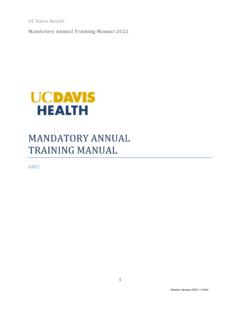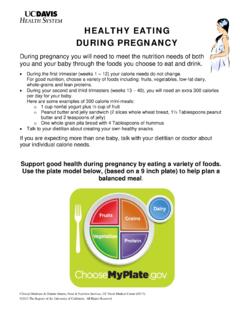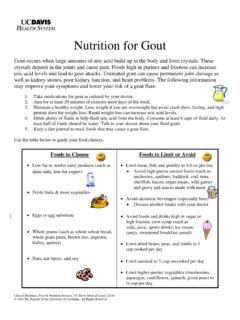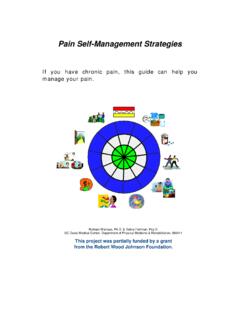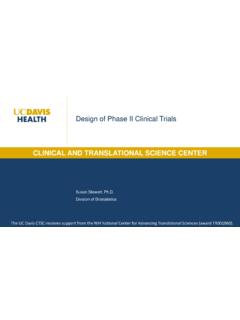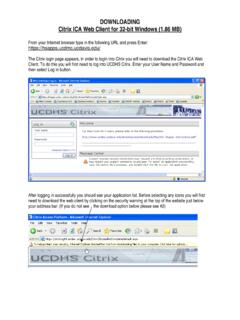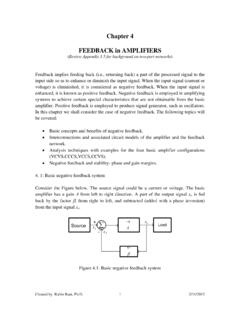Transcription of Essential IND Strategies: Fundamental Considerations on ...
1 Essential IND Strategies: Fundamental Considerations on the Road to Success Darren Warren Drug Discovery & Development Target Identification HTS (High Throughput Screening) Actives to Hits Hit to Lead Lead Optimization (SAR) Preclinical Candidate IND Enabling & Registration Support Studies Clinical Candidate NDA Phase I - III Market Introduction Phase IV API Synthesis, Analytical & Scale-up Focus of Today s Discussion Early Clinical Goals & Regulatory Strategy 1)Define drug development goals: Identify target patient population, rationale for clinical need, & initial region for clinical development. Goal should not simply be to file an IND, rather develop a drug therapy 2)Initial clinical trials designed to characterize: Human DMPK, safety, pharmacologic activity & proof of concept 3)Understand regulatory guidelines and precedented approaches for similar drugs (same chemical class & indication or relevant) 4)Chemical development strategies: Develop robust API synthetic route that yields appropriate physical/chemical properties; clinically suitable drug formulations, with well characterized impurity profiles.
2 5)IND-enabling pharmacology, DMPK & toxicology studies: Need to align with clinical route of administration, dose schedules, & duration of treatment. Design to identify: PK/PD responses, target organs, dose response, exposure multiples & safety margins Drug Integrated Process In Vitro ADME Log D, Solubility Cytotoxicity Protein binding Permeability Metabolism CYP Assays Clinical & Regulatory Support Clinical Sciences Ph 1 Pk/Safety & Ph 2 Efficacy designs Regulatory strategies & submissions Preclinical Development Pharmacology Metabolism studies Animal models Pharmacokinetics Toxicology (IND & beyond) Chemical Services cGMP synthesis (grams to kilos) Process chemistry Analytical chemistry Process development & engineering DMPK Bioanalytical method development and validation Bioanalytical sample analysis PK & metabolite profiling Pitfall #1.
3 The Rush to First Dose Manufacture of test article, development of analytical and bioanalytical methods, development of appropriate dosing formulations and as necessary preformulation work all occur before first dose. ItemPhase IRange-FindingGLP ToxicologyAPI Needed50 - 200 - kilograms2 - 10 kilogramsProcess StatusDiscovery routeUpgraded to scaleable and reliableUpgraded to scaleable and reliablePreparation Scale5 - 12 liters50 liters200 - 400 litersAPI Purity> 95%97%NLT 98%Analytical MethodsID/purity - TANP urity - TANP urity - weight-basedRelated substances - TANR elated substances - TANS olvents - totalResidual Solvents - ICH GuidelinesCounter ionProcess residuesPre-ClinicalAPI Supply Targets API Need ForAmount, gramsDose Range Finding Studies100 Salt Screen10 Polymorph Screen10 GLP Toxicology Studies1,000 Formulations research100 Reference Standard50 Phase I3,000 Stability Study25ST4,295 Program Contingency @ 25%1,074ST5,369 Mass Contingency @ 25%1,342 Program Total6,711 Map out your API Supply Target = Requirement * (1 + (MC/100))
4 Process StatusAmount Prepared gramsMass Contingency, % (MC)Discovery Route< 10100 - 200 Some Process Research> 10050 Process research/Scale-Up Changes> 25025 Map out your API Supply Typical API Specification Phase I Property/AttributeMethodSpecificationApp earanceVisualOff-white powderIdentityH NMRM atches reference standardC NMRM atches reference standardMass SpectrumMatches reference standardElemental AnalysisConsistent with structurePurityHPLCNLT (w)Impurity ProfileHPLCNo single impurity > impurities NMT resultMelting RangeDSCR eport ResultResidual SolventsGCConforms to ICH LimitsHeavy MetalsTitrationNMT 20 ppmResidual PalladiumICPNMT 10 ppmResidue on IgnitionCombustionNMT FischerNMT Preparation Strategies Model C Dose Range-Finding Lot Toxicology/Phase I Lots Toxicology LotPhase I LotStarting MaterialRegulatory StartingMaterialAPI Preparation Strategies Advantages Utilizes dose range finding data to set needs Can control impurity profile difference between Toxicology and Phase I lots Balances scale-up risk and preparation time Disadvantages May have slight delay in Toxicology lot delivery Complete process run more than 2 times Model C Dose Range-Finding Lot Toxicology/Phase I Lots API Supplies Program Progression ItemPre-ClinicalCommercialPhase IPhase IIPhase IIIP roductionAPI Amount.
5 - 31 - 1050 - 200> 200>1,000 Process StatusDiscovery RouteProcess Scaleable and ReliableProcess Intended for Commercial UseProcess Developed and ValidatedProcess Locked for Routine ProductionPreparation Scale, liters 1 - 50 - Kilo-Lab50 - 400 Small Pilot Plant2000 - Pilot Plant> 2,000 - Semi- Works> 8,000 Analytical MethodsTAN-based HPLC PurityMethods fully developed, validated, and locked for production supportAPI CharacterizationRudimentaryComprehensive using validated methodsRoutine Quality Control testing for production support and API releaseAPI Purity, %959898+98+98+SpecificationsID and purityLockedcGMP ControlsNoneFull routine complianceRequired = application rigor increases with process knowledge and experience and phaseAPI for Clinical Trial MaterialsWeight-based purity, related substances residual solvents, and other methods are developed and validated in proportion to the clinical phraseCharacterization becomes more complete as process knowledge and experience increasesSpecifications refined and tightened as process API Preparation Planning Capacity Model StepStep ProductMWYieldProcessTotalBatchesCycleRu n%kg-moleskgsOutputWorkingSizeUsageMOCTi meTimeg/lVolumeliters% RequiredCAPACITY MODELBATCH SEQUENCING PLANA mount RequiredReactor SpecificsDMPK & Early Development Critical for Non-clinical Species Selection & Prediction of Human DMPK Responses In Vitro Metabolism Plasma stability Protein binding Blood compatibility Microsomal/Hepatocyte stability & metabolism Species comparison in microsomes & hepatocytes Define metabolic pathway and major metabolites.
6 Metabolite structure elucidation Pharmacokinetics (PK) & Toxicokinetics (TK) Lead & Formulation selection, pilot PK Bioavailability & complete PK profiles In vivo metabolite profiling & ADME studies (using cold or radio-labeled compound). Conducted preclinically or early Phase 1. DMPK & Early Development Critical for predicting Drug-Drug Interactions; interpreting PK & tox outcomes; & prediction of human PK profiles Drug-Drug Interaction (DDI) CYP Assays: Consider patient population & co-therapies Inhibition (cocktail & individual assays, IC50 and Ki) Mechanism based inhibitor (MBI) determination Induction In vitro induction in hepatocytes Toxicology/TK data can provide early indicators of induction Ex vivo induction in liver from treated animals Reporter gene assays for induction of CYP1A2 & CYP3A4 UGT enzyme inhibition Cell Transport Drug Transporters Permeability (Caco2, uni- and bidirectional) MDR1-MDCK bidirectional permeability (P-gp) Uptake transporter assays Pharmacokinetics Define Active Drug Concentration & PK profiles (major & relevant metabolites) AUC, Cmax/Cmin, Tmax, T1/2, Vd, & Cl Characterize over range of dosages, including expected clinical and toxicology dosages (1x-10x efficacious dosages) Single & Repeat-dose PK (3-7 days)
7 Defines saturation of absorption, metabolism, clearance/excretion, accumulation, gender and species differences ADME Not generally required for IND Will need to identify and characterize major/relevant metabolites Helpful to understand primary routes of excretion & tissue distribution Pharmacokinetics & Metabolism Drug Safety GLP vs non-GLP Any study can be conducted in accordance with GLP GLP incurs increased cost and timelines GLP (only) required for extrapolation to humans Species Selection Selection based on in vitro metabolism and PK data Major metabolites must be expressed in tox species Rodent (mice, rats) Non-Rodent (dogs, nonhuman primates) Gottingen mini-pigs, rabbits, etc. as justified Requirement for two species may be waived (ex. no pharmacology in rodent species for biologics) Non-GLP & GLP Toxicology & Safety Pharmacology Studies Dose Administration & Schedule Should be the same as intended clinical route & schedule Dose schedule: daily (or multiple daily) vs.
8 Cycle dosing Oral: gavage, nasogastric route, oral tablet/capsule or solution Parenteral: intravenous, continuous intravenous infusion, subcutaneous, intramuscular, intraperitoneal Topical: dermal, ocular Regional treatment: intra-tendon, intra-articular and intra-vitreal Characterize dose-response relationship Minimum of 3 dosages Good separation between dosages to avoid exposure overlap Dose to toxic effect or maximum feasible limit Non-GLP & GLP Toxicology & Safety Pharmacology Studies Drug Safety Drug Safety Pilot Toxicology Studies Initial toxicity readouts (single and multiple dose) Required in each species, non-GLP Tolerability - define the Maximum Tolerated Dose (MTD): single dose; morbidity/mortality, GI distress, severe CNS effects, respiratory distress, immune reactions Repeat Dose Range-Finding Toxicity: repeat dose 5-14 days; identify dose & exposure responses, target organ toxicity; major organ system pathology; dose-limiting toxicities; repeat-dose TK A go/no-go decision often follows: Toxicity profile?
9 PK profile? Dose limitations? Off target tox? Toxicology Studies Pitfall: not considering your formulations carefully Pitfall: not conducting complete / robust pilot tox studies IND-enabling (pivotal) GLP Typically 14-28 day repeat dose to support SAD & MAD Ph I clinical studies Intended as survey studies. Expected to include endpoints relevant to molecular class, anticipated toxicity, PD identification Dose selection intended to elicit toxicity Primary endpoints are clinical pathology & anatomical pathology assessments with TK profile correlates Goals: Identify target organ toxicity/pathology, translational predictive safety biomarkers, assess reversibility or progression, assess local tolerance, determine adverse effects with NOAEL & exposure ratios Basis for selecting initial clinical doses & escalation. Toxicology Studies Drug Safety Specific assessments as indicated Local effects (ex.)
10 Injection or application site) Specific safety biomarkers as appropriate (clinical pathology or specialty assay) Immunogenicity as warranted (anti-drug antibody) Immune suppression or cytokine storm Common concerns / issues Blood volume limitations for large animals TA consumption substantial TA preferred same batch as Ph I Maintain purity of purpose = IND enabling. Avoid discovery investigations; pitfall for including unneeded endpoints Drug Safety IND-Enabling Toxicology Drug Safety Hazard Identification for DNA damage in form of mutations or chromosomal damage Pre-IND requirement for 2 in vitro assays: AMES & Mammalian in vitro Chromosomal Aberration assay Registration Requirement for in vivo Chrome Ab assay (Micronucleus Test) Prudence in conducting all 3 assays pre-IND Additional clarification assays as needed (example to show epigenetic or mechanism based effects) Does not address potential genotoxic impurities in API Genetic Toxicology Requirements ICH Core Battery.
